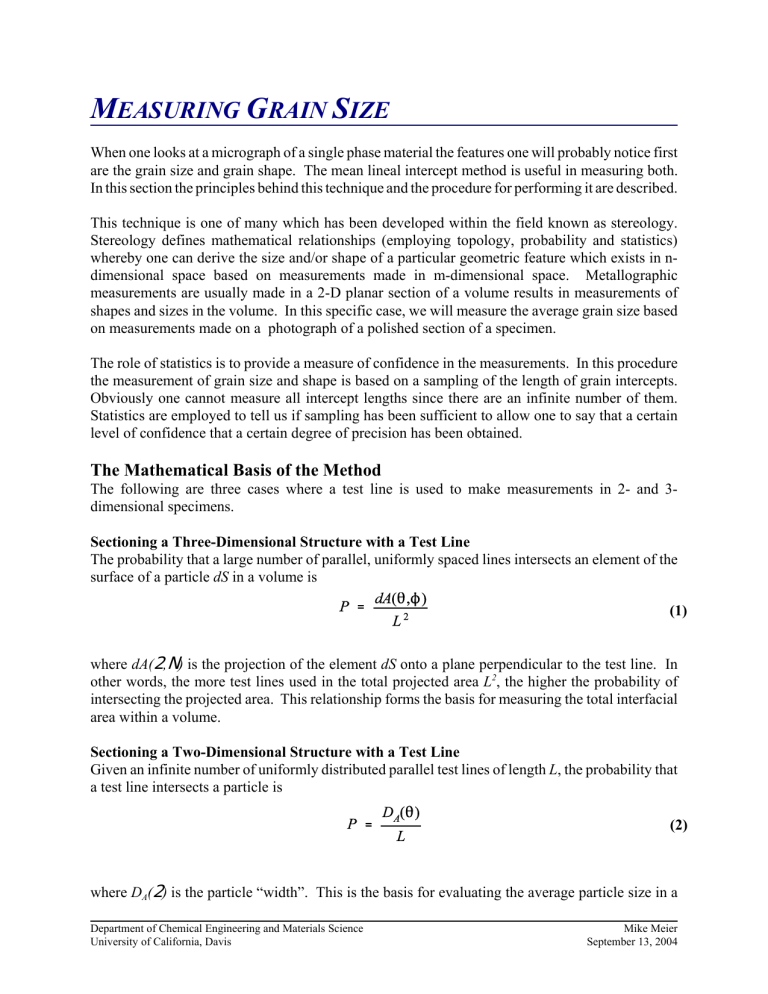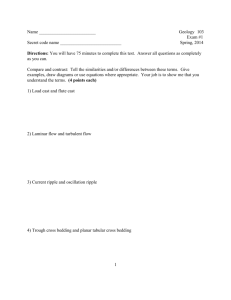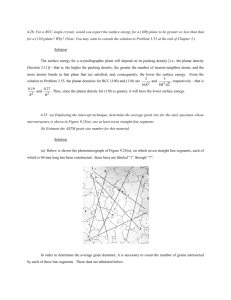Measuring Grain Size

M
EASURING
G
RAIN
S
IZE
When one looks at a micrograph of a single phase material the features one will probably notice first are the grain size and grain shape. The mean lineal intercept method is useful in measuring both.
In this section the principles behind this technique and the procedure for performing it are described.
This technique is one of many which has been developed within the field known as stereology.
Stereology defines mathematical relationships (employing topology, probability and statistics) whereby one can derive the size and/or shape of a particular geometric feature which exists in ndimensional space based on measurements made in m-dimensional space. Metallographic measurements are usually made in a 2-D planar section of a volume results in measurements of shapes and sizes in the volume. In this specific case, we will measure the average grain size based on measurements made on a photograph of a polished section of a specimen.
The role of statistics is to provide a measure of confidence in the measurements. In this procedure the measurement of grain size and shape is based on a sampling of the length of grain intercepts.
Obviously one cannot measure all intercept lengths since there are an infinite number of them.
Statistics are employed to tell us if sampling has been sufficient to allow one to say that a certain level of confidence that a certain degree of precision has been obtained.
The Mathematical Basis of the Method
The following are three cases where a test line is used to make measurements in 2- and 3dimensional specimens.
Sectioning a Three-Dimensional Structure with a Test Line
The probability that a large number of parallel, uniformly spaced lines intersects an element of the surface of a particle dS in a volume is
(1) where dA( 2 , N ) is the projection of the element dS onto a plane perpendicular to the test line. In other words, the more test lines used in the total projected area L 2 , the higher the probability of intersecting the projected area. This relationship forms the basis for measuring the total interfacial area within a volume.
Sectioning a Two-Dimensional Structure with a Test Line
Given an infinite number of uniformly distributed parallel test lines of length L , the probability that a test line intersects a particle is
(2) where D
A
( 2 ) is the particle “width”. This is the basis for evaluating the average particle size in a
Department of Chemical Engineering and Materials Science
University of California, Davis
Mike Meier
September 13, 2004
two dimensional structure.
The probability that a test line intersects the outline of the particle is
(3) where dx(
2
) is the projection of an element of the outline onto a line perpendicular to the test line.
The is the basis for measuring the total perimeter of particles in a two dimensional structure.
General Methods
The following are two general methods for measuring grain size using a test line. The first method defines the mean lineal intercept while the second method can be expressed in terms of the mean lineal intercept.
1. Mean Lineal Intercept
The mean lineal intercept length is determined by laying a series of uniformly distributed test lines on the planar section and counting the number of times that grain boundaries are intercepted.
(4)
Where N
L
is the number of intercepts per total length of the test lines, L
T
, P is the total number of grain boundary intersections and M is the magnification.
2. ASTM Grain Size
The ASTM grain size number is based on the number of grains per square inch at a magnification of 100X
(5) or the equivalent grain size number from the mean intercept length
(6) where L
L
is given in millimeters and the magnification is 1X. This method requires that at least 50 grains be counted and that the area of observation must be converted to its equivalent at 100X. The precision of the estimate of the actual magnification must be at least 5% when ASTM grain sizes are to be determined to the nearest ½ ASTM size number.
The Preferred Method
The following is the preferred method of measuring grain size.
Measurement of Grain Size Using the Mean Lineal Intercept Method (Heyn)
ASTM Standard E 112-88 describes the lineal intercept method in general and the Heyn procedure in particular. This method employs the lineal intercept technique to determine the ASTM grain size number. The following is a sketch of the Heyn procedure:
1. Magnification, Test Line and Fields
C Ideally, the length of a single test line and the magnification should be such that 50 intercepts can be counted. This will permit estimation of the ASTM grain size to the nearest whole grain size number.
C The use of multiple fields to obtain 50 intercepts is discouraged, although permitted, due to the bias which will decrease the accuracy as the number of fields increases.
2. Count the intercepts...
C An intercept is the segment of the test line which overlays one grain.
C Count 1 for each intercept and ½ for each time an end of the test line falls on a grain.
... or count the intersections
C An intersection is the point where the test line cuts a grain boundary.
C Count 1 for each intersection, 1 for each tangential intersection, ½ when an end of the test line ends exactly on a grain boundary and 1½ when the intersection occurs at a triple point.
3. Measurement Strategy
C Make counts on 3 to 5 blindly selected and widely separate fields to obtain a reasonable average for the specimen. Additional counts may be required to obtain the desired accuracy.
C Use four or more orientations of the test line to eliminate effects due the moderate departures from equiaxed structure.
C Use orthogonal sets of parallel test lines if the structure is distinctly non-equiaxed.
•
4. Tabulate the Results
If measurements were made in the longitudinal, transverse and normal directions then the number of grains per unit volume can be calculated as
(7)
• For non-equiaxed grains calculate the ASTM grain size number based on the number of grains per volume and then append as subscripts the ratios of the average values of N
L,n and N
L,n
/N
L,t
. For example, given that
/N
L,l
(8) equation 7 gives N
V
= 6026 (which is equivalent to ASTM grain size number 5.5).
(9)
•
•
•
So the ASTM grain size number is reported as 5.5
4,2
.
It may be inconvenient to use the ASTM grain size or the number of intersection per area in further analysis of the results. Often these results are reported as an equivalent grain diameter, grains per unit volume, etc.
To convert from the mean lineal intercept length to the caliper diameter of a sphere multiply by 1.5000.
It is important to remember that the mean lineal intercept method is actually a measure of the total interfacial area per unit volume. The assumptions made in this method regarding the shape of the grains is not to be taken for granted. While an equiaxed grain can be approximated as a sphere (an ideal grain is a truncated dodecahedron (14 faces)) small errors
(bias) will be found in the results. If the grains are elongated (approximated as either a prolate or oblate ellipsoid) the errors can be significant.







